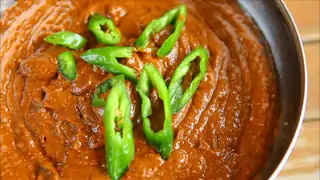 | |
| Type | Condiment |
|---|---|
| Place of origin | Korea |
| Associated cuisine | Korean cuisine |
| Main ingredients | Gochujang, doenjang |
| Korean name | |
| Hangul | 쌈장 |
|---|---|
| Hanja | 쌈醬 |
| Revised Romanization | ssamjang |
| McCune–Reischauer | ssamjang |
| IPA | [s͈am.dʑaŋ] |
.jpg.webp) |
| This article is part of a series on |
| Korean cuisine 한국 요리 조선 료리 |
|---|
Ssamjang (Korean: 쌈장) is a thick, spicy paste used with food wrapped in a leaf in Korean cuisine. The sauce is made of fermented soy beans (doenjang), red chili paste (gochujang), sesame oil, onion, garlic, green onions, and optionally brown sugar.[1][2][3][4]
Etymology
Ssam means "wrapped" and jang means "paste" or "thick sauce". Together as ssamjang they mean "wrapping sauce".
Variations
Besides the standard way of making ssamjang, other ingredients can be added to make special versions.[5] There are also commercially prepacked ssamjang available on the market.[6]
- Nut ssamjang (견과류 쌈장): ground walnuts, pumpkin seeds, sunflower seeds, and other nuts are added
- Jjukumi ssamjang (쭈꾸미 쌈장): diced short-arm octopus is stir-fried with diced red peppers and onions, and mixed together with ssamjang
- Tofu ssamjang (두부 쌈장): crushed tofu is added
- Flying fish roe ssamjang (날치알 쌈장): flying fish roe is added
- Namul ssamjang (나물 쌈장): various beans are diced and added
- River snail ssamjang (우렁이 쌈장): boil the water with doenjang, river snail, green onion, garlic, and red pepper powder.[7]
See also
References
- ↑ (in Korean) Ssamjang at Doosan Encyclopedia
- ↑ "Ssam Jang".
- ↑ "Ssamjang Recipe hannaone". Chowhound.
- ↑ "Korean Food | Ssamjang | Mixed Soybean & Chili Pepper Paste". www.trifood.com. Archived from the original on 2011-07-14. Retrieved 2021-01-24.
- ↑ (in Korean) Mom's ssamjang, Segye Ilbo, 2010-04-15.Retrieved 2010-06-25.
- ↑ (in Korean) Comparison of ssamjang, Sports Seoul, 2009-03-19. Retrieved 2010-06-25.
- ↑ "우렁이쌈장". terms.naver.com (in Korean). Retrieved 2021-05-16.
This article is issued from Wikipedia. The text is licensed under Creative Commons - Attribution - Sharealike. Additional terms may apply for the media files.